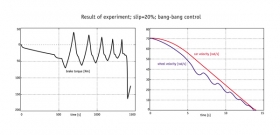ABS Antilock Braking System
The automotive engineering system to control the wheel slip
Antilock Braking Systems are designed to optimize braking effectiveness while maintaining car controllability. The ABS model is driven by a flat DC motor steered from a PC. There are three encoders measuring the rotational angles of two wheels and the lever angle of the car wheel suspension.
 At the beginning of an experiment the wheel simulating the relative road motion is accelerated to a given threshold velocity. The car wheel accelerates following the rotational motion of the “road” wheel. At the threshold a braking procedure starts. If the car wheel becomes motionless it means that it remains in slip motion (the car velocity is not equal to zero) or is absolutely stopped. The less the slip the better car control. One of the pre-programmed slip control algorithms can be applied.
At the beginning of an experiment the wheel simulating the relative road motion is accelerated to a given threshold velocity. The car wheel accelerates following the rotational motion of the “road” wheel. At the threshold a braking procedure starts. If the car wheel becomes motionless it means that it remains in slip motion (the car velocity is not equal to zero) or is absolutely stopped. The less the slip the better car control. One of the pre-programmed slip control algorithms can be applied.
 Hardware:
Hardware:
- mechanical unit: rigid frame, double wheel, DC high-torque flat motor, electromechanical brake and shock absorber
- position sensors: incremental encoders
- power interface
- RT-DAC I/O internal PCI or external USB board (PWM control and encoder logics are stored in a XILINX chip)
Dimensions:
600x370x580 mm
